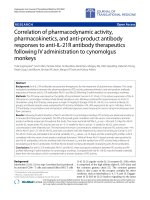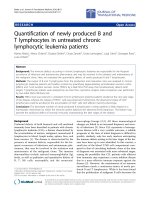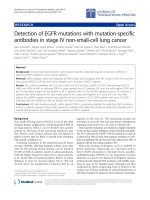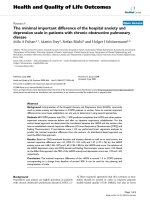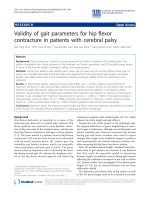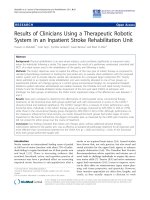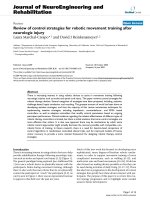báo cáo hóa học:" Assessment of the structure of the Hospital Anxiety and Depression Scale in musculoskeletal patients" pdf
Bạn đang xem bản rút gọn của tài liệu. Xem và tải ngay bản đầy đủ của tài liệu tại đây (284.9 KB, 9 trang )
BioMed Central
Page 1 of 9
(page number not for citation purposes)
Health and Quality of Life Outcomes
Open Access
Research
Assessment of the structure of the Hospital Anxiety and Depression
Scale in musculoskeletal patients
Julie F Pallant*
†
and Catherine M Bailey
†
Address: Faculty of Life and Social Sciences, Swinburne University of Technology, P.O. Box 218, Hawthorn, Victoria 3122, Melbourne, Australia
Email: Julie F Pallant* - ; Catherine M Bailey -
* Corresponding author †Equal contributors
Abstract
Background: Research suggests there is a high prevalence of anxiety and depression amongst
patients with chronic musculoskeletal pain, which can influence the effectiveness of rehabilitation
programs. It is therefore important for clinicians involved in musculoskeletal rehabilitation
programs to consider screening patients for elevated levels of anxiety and depression and to
provide appropriate counselling or treatment where necessary. The HADS has been used as a
screening tool for assessment of anxiety and depression in a wide variety of clinical groups. Recent
research however has questioned its suitability for use with some patient groups due to problems
with dimensionality and the behaviour of individual items. The aim of this study is to assess the
underlying structure and psychometric properties of the HADS among patients attending
musculoskeletal rehabilitation.
Methods: Data was obtained from 296 patients attending an outpatient musculoskeletal pain clinic.
The total sample was used to identify the proportion of patients with elevated levels of anxiety and
depression. Half the sample (n = 142) was used for exploratory factor analysis (EFA), with the
holdout sample (n = 154) used for confirmatory factor analysis (CFA) to explore the underlying
structure of the scale.
Results: A substantial proportion of patients were classified as probable cases on the HADS
Anxiety subscale (38.2%) and HADS Depression subscale (30.1%), with the sample recording
higher mean HADS subscales scores than many other patient groups (breast cancer, end-stage
renal disease, heart disease) reported in the literature. EFA supported a two factor structure
(representing anxiety and depression) as proposed by the scale's authors, however item 7 (an
anxiety item) failed to load appropriately. Removing Item 7 resulted in a clear two factor solution
in both EFA and CFA.
Conclusion: The high levels of anxiety and depression detected in this sample suggests that
screening for psychological comorbidity is important in musculoskeletal rehabilitation settings. It is
necessary for clinicians who are considering using the HADS as a screening tool to first assess its
suitability with their particular patient group. Although EFA and CFA supported the presence of
two subscales representing anxiety and depression, the results with this musculoskeletal sample
suggest that item 7 should be removed from the anxiety subscale.
Published: 19 December 2005
Health and Quality of Life Outcomes 2005, 3:82 doi:10.1186/1477-7525-3-82
Received: 08 November 2005
Accepted: 19 December 2005
This article is available from: />© 2005 Pallant and Bailey; licensee BioMed Central Ltd.
This is an Open Access article distributed under the terms of the Creative Commons Attribution License ( />),
which permits unrestricted use, distribution, and reproduction in any medium, provided the original work is properly cited.
Health and Quality of Life Outcomes 2005, 3:82 />Page 2 of 9
(page number not for citation purposes)
Background
Anxiety and depression are major factors impacting
patient's quality of life, and the associated symptoms (ina-
bility to concentrate, loss of motivation, disturbed sleep,
fatigue, pessimistic mood) may influence their ability to
benefit from treatment and rehabilitation programs. High
levels of anxiety have been associated with poor concen-
tration and difficulty in comprehending information pro-
vided by clinicians [1]. Depressed mood may also
adversely affect patients' willingness to comply with pre-
scribed medications and to undertake the necessary life-
style changes (eg. exercise, diet).
Studies have found quite high levels of psychological dis-
tress among patients with musculoskeletal diseases in par-
ticular [2,3]. It is therefore important for clinicians
involved in musculoskeletal rehabilitation programs to
consider screening patients for elevated levels of anxiety
and depression and to provide appropriate counselling or
treatment where necessary. Reduction in levels of anxiety
and depression should also be considered an important
program outcome.
One of the issues facing clinicians wishing to screen for
high levels of anxiety and depression among their patients
is the choice of a screening tool. In a hospital setting, the
tool needs to be quickly administered, easy to use and
have good psychometric properties. Many of the available
measures (eg. Beck Depression Inventory [4]) are quite
long and detailed, and are restricted for use by psycholo-
gists, psychiatrists, or other suitably trained personnel.
This makes them unsuitable for routine administration as
part of the normal pre-program assessment procedures.
In the selection of assessment tools for screening and eval-
uation there are a number of issues to be considered. Guy-
att, Feeny, and Patrick [5] in their guidelines on the
selection of health related quality of life measures high-
light a number of factors that are relevant here (for a more
comprehensive review see Streiner and Norman, [6]).
Measures need to be reliable (internally consistent, and
stable over time), valid (measuring the intended charac-
teristic), and responsive (able to detect change). Reliabil-
ity, accuracy and reproducibility are important qualities
for a discriminative instrument (for use as a screening tool
in distinguishing those with high versus low levels of a
characteristic). For an evaluative instrument, responsive-
ness (as indicated by sensitivity to detect changes in
patients who have improved or deteriorated) is also essen-
tial.
One of the tools that could be considered for use as a dis-
criminative measure in the rehabilitation context is the
Hospital Anxiety and Depression Scale (HADS) [7]. It was
originally developed as a short questionnaire designed to
identify clinical 'caseness' for anxiety and depression in
general medical outpatient populations. The items
included in the HADS were chosen to reduce contamina-
tion with somatic symptoms, which are common in
patient populations. The HADS consists of an anxiety and
depression subscale, each containing seven items, making
it quick and easy to use in clinical settings.
Since its publication in the early 1980's the HADS has
been used in a growing number of studies across a variety
of patient groups and clinical contexts (see review by Bjel-
land, et al., [8]). As a brief screening tool the HADS scale
is increasing in popularity, particularly in clinical settings,
because of its ease of administration and independence
from physical symptomatology. After reviewing over 70
journal articles Bjelland and coauthors [8] concluded that
the HADS 'performs well in screening for the separate
dimensions of anxiety and depression and caseness of
anxiety disorders and depression in patients from non-
psychiatric hospital clinics' (p. 75).
The HADS was originally designed to assess two separate
dimensions of anxiety and depression. The case for the
bidimensionality of the HADS was supported in a review
paper published by Bjelland et al. [8]. Of the 18 studies
reviewed that reported findings of factor analyses, eleven
of the papers supported a two-factor solution. A strong
argument for the use of the two factors is also made at the
clinical level [9] where it is clinically relevant to separately
determine levels of anxiety and depression.
In twenty-one studies investigating the HADS, the Pearson
correlation coefficients between the two subscales of anx-
iety and depression were reported to have a mean of .56
[8]. These high correlation rates have encouraged some
authors to question the dimensionality of the scale.
Razavi, Delvaux, Farvacques and Robaye [10] recom-
mended totalling the two subscales to create a total score
of generalised psychological distress. Martin, Tweed and
Metcalfe [11] in a study of patients with end-stage renal
disease, suggested that it may be 'appropriate to consider
adopting a global total score of psychological distress' (p.
61) as an alternative to the original two subscale structure.
A growing number of authors have argued that there are
three or more factors contained within the scale [12-14].
In a recent review of the HADS, Martin [15] states that
'there is accumulating evidence that the fundamental fac-
tor structure of the HADS comprises not two, but three
factors and indeed, that the three-factor structure offers a
superior fit to clinical data than the two factor (anxiety
and depression model)' (p.70). Drawing on Clark and
Watson's [16] tripartite theory of anxiety and depression,
Dunbar and colleagues [12] found empirical support
using confirmatory factor analysis (CFA) for a three factor
Health and Quality of Life Outcomes 2005, 3:82 />Page 3 of 9
(page number not for citation purposes)
model of the HADS, distinguishing autonomic anxiety
(items 3,9,13), negative affectivity (items 1,5,7,11) and
anhedonic depression (items 7,2,4,6,8,10,12,14). Item 7
(an anxiety item) was found to load on two factors (nega-
tive affectivity and depression). Martin [15] suggests that
the autonomic arousal component of the HADS anxiety
subscale may be a potential confounding factor when
used with patients experiencing physical symptoms,
affecting its reliability as a screening tool.
Another issue that has been raised in regard to the HADS
is the appropriateness of individual items with specific
patient groups [17]. The review by Bjelland et al. [8]
revealed that the anxiety item 7 "I can sit at ease, and feel
relaxed" showed consistently low correlations with the
anxiety subscale, and higher correlations with the depres-
sion subscale across a range of patient groups.
Although used extensively with some patient groups (eg.
cancer patients) there appears to be relatively little good
quality research into the psychometric properties of the
HADS for use in a rehabilitation context. One exception is
a study conducted by Harter et al. [18] in a number of in-
patient rehabilitation clinics in Germany, which assessed
the HADS (as compared with the General Health Ques-
tionnaire: GHQ) as a screening tool with musculoskeletal
patients. The accuracy of the diagnostic ability of the
HADS (sensitivity and specificity) compared to standard-
ised interviews was found to be superior to that of the
commonly used GHQ. Harter et al. [18], recommend the
HADS 'as an efficient instrument to identify patients with
musculoskeletal disease and potential psychiatric comor-
bidity' (p. 743). Based on the findings of their study they
propose that the assessment and identification of patients
with high levels of anxiety and depression should be given
high priority, particularly given their influence on aspects
such as quality of life, pain experiences and treatment
conformity.
Although the Harter et al. [18] study appears to support
the use of the HADS in rehabilitation settings, the authors
chose to use the HADS as a total score, rather than as two
subscales, as recommended by the scale developers. No
justification was given for this decision, and no analyses
were conducted to evaluate the appropriateness of this
approach. Ideally factor analysis could have been under-
taken to assess the structure of the HADS in the rehabili-
tation context, and to evaluate its psychometric
properties.
The aim of this study therefore was to assess the suitability
of the HADS as a screening tool for routine use in rehabil-
itation settings for patients with musculoskeletal disor-
ders. This paper assesses the levels of anxiety and
depression in a sample of musculoskeletal patients, and
explores the dimensionality of the scale using both
exploratory and confirmatory factor analysis.
Methods
Participants
The sample consisted of 296 outpatients attending a 6-
week musculoskeletal rehabilitation program at Cedar
Court HealthSouth Hospital, a private rehabilitation hos-
pital in Melbourne, Australia. There were 152 (51.4%)
females, 140 (47.9%) males), 4 cases (1.4 %) sex unspec-
ified. Patients ranged in age from 16 yrs to 80 yrs (mean =
44.3, SD = 12.47). Fifty-five percent of patients reported
pain in the lower back, 20% in an upper or lower limb,
15% in the cervical region and 10% in other locations.
Procedure
The HADS is routinely administered to all patients on
admission to the Cedar Court HealthSouth Hospital reha-
bilitation program as part of standard clinical procedures.
Scores on the HADS from all patients attending the pro-
gram between 2001 and 2003 were extracted from the
medical records for this study, with permission from the
Hospital Research Committee.
From the original sample of 296 cases, the dataset was
randomly divided into two separate and independent
sub-samples. The first sample contained 142 cases and
was subjected to exploratory factor analysis. The second
sample of 154 was used as an independent, holdout sam-
ple for confirmatory factor analysis. Although this proce-
dure resulted in two smaller samples it was considered
important to use both an exploratory and confirmatory
approach with this sample of musculoskeletal patients. It
was not appropriate to only use CFA, as the structure of
the HADS in musculoskeletal patients had not been previ-
ously established using exploratory approaches. Although
the sample sizes were smaller than desirable for these
analyses, they are similar to other recent studies assessing
the HADS on specific clinical samples. Jomeen & Martin
[19] conducted both EFA and CFA on a sample of 101
antenatal women; Bedford, Pauw and Grant [20] used a
sample of 132 adult psychiatric outpatients; and the sam-
ple used by Martin, Tweed & Metcalfe [11] consisted on
160 end stage renal patients. According to Tabachnick and
Fidell [21] sample sizes of 150 should be sufficient when
solutions show several high loading marker variables
(>.80).
Measures
Hospital Anxiety and Depression Scale (HADS [7]) is a
14-item scale designed to detect anxiety and depression,
independent of somatic symptoms. It consists of two 7-
item subscales measuring depression and anxiety. A 4-
point response scale (from 0 representing absence of
symptoms, to 3 representing maximum symptomatology)
Health and Quality of Life Outcomes 2005, 3:82 />Page 4 of 9
(page number not for citation purposes)
is used, with possible scores for each subscale ranging
from 0 to 21. Higher scores indicate higher levels of disor-
der. A number of clinical classification schemes have been
used to categorise scores on the HADS. In the original arti-
cle the following cut offs were suggested: 0–7 = 'non-
cases'; 8–10 = 'possible case'; 11–21 = 'probable case'.
Statistical analysis
The reliability of the two subscales was assessed using
Cronbach alpha coefficients. The underlying structure of
the HADS was explored using both exploratory factor
analysis (EFA) and confirmatory factor analysis (CFA).
EFA was performed on the first sample using SPSS version
11.5, after first confirming that the data was suitable for
factor analysis. Principal components analysis (PCA) was
used to extract the factors followed by oblique rotation of
factors using Oblimin rotation (delta = 0). The number of
factors to be retained was guided by three decision rules:
Kaiser's criterion (eigenvalues above 1), inspection of the
screeplot, and by the use of Horn's parallel analysis [22]
(Horn, 1965). Parallel analysis is one of the most accurate
approaches to estimating the number of components
[23,24]. The size of eigenvalues obtained from PCA are
compared with those obtained from a randomly gener-
ated data set of the same size. Only factors with eigenval-
ues exceeding the values obtained from the corresponding
random data set are retained for further investigation. Par-
allel analysis was conducted using the software developed
by Watkins [25].
Confirmatory factor analysis (CFA) using maximum like-
lihood estimation was conducted on the second holdout
sample using AMOS Version 4 [26] to evaluate model fit.
Although good model fit can be indicated by a non-signif-
icant chi-square, in practice other factors can influence
this figure, and therefore a range of fit statistics were
assessed. For the incremental fit statistics (Goodness of Fit
Index :GFI; the Tucker-Lewis Index :TLI; and the Compar-
ative Fit index: CFI) values less than .90 indicate lack of fit,
values between .90 and .95 indicate reasonable fit and val-
ues between .95 and 1.00 indicate good fit [21]. Byrne
[27] describes the Root Mean-Square Error of Approxima-
tion (RMSEA) as the most informative statistic in deter-
mining model fit as it takes into account the number of
variables that are estimated in the model. RMSEA values
are required to be .05 or lower to indicate good fit. Values
between .05 and .08 indicate reasonable fit.
Results
Descriptive statistics
Scores on the HADS Anxiety scale ranged from 0 to 21,
with a mean of 9.26 (SD = 4.43) and a median of 9.0.
HADS Depression scale scores also covered the full range
from 0 to 21, with a mean of 8.14 (SD = 4.43) and a
median of 8.0. Scores on both subscales showed an
approximately normal distribution.
The mean scores obtained in this sample on the HADS
Anxiety and Depression scales were compared with the
scores reported in the literature for other patient groups
(see Table 1). The comparison of these subscale scores
indicated that this musculoskeletal sample's anxiety and
depression levels are higher than each of the clinical sam-
ples (cancer [28], end-stage renal disease [29], chronic
obstructive pulmonary disease [30], coronary heart dis-
ease [31]) samples listed, but lower than that obtained
from a sample of psychiatric patients.
Patients' scores were classified into the clinical categories
defined by the scale's authors. For the anxiety subscale
38.2% of patients were classified as a probable case (score
11 to 21), with a further 23% classified as a possible case
(score 8 to 10). On the depression subscale 30.1% were
classified as probable cases (score 11 to 21) and 21.3% as
possible cases (score 8 to 10).
Reliability
The Cronbach alpha value for the anxiety subscale was
.83, while the Cronbach alpha value for the depression
subscale was .84. Both values exceeded the recommended
value of .7 [32], indicating adequate internal consistency.
Exploratory factor analysis
The sample was first assessed for its suitability for factor
analysis. Bartlett's Test of Sphericity was highly significant
(p < .001) and the Kaiser-Meyer-Olkin (KMO) measure of
Table 1: Comparison of HADS anxiety and depression subscale mean scores with other samples
Sample HADS Anxiety HADS Depression
Current sample of Musculoskeletal patients 9.26 8.14
Non clinical UK normative sample [37] 6.14 3.68
Coronary heart disease patients [31] 6.14 5.41
End-stage renal patients [29] 6.90 5.20
Breast cancer patients [28] 7.43 3.25
Chronic Obstructive Pulmonary Disease
rehabilitation patients [30]
7.10 5.80
Psychiatric patients [20] 13.90 9.90
Health and Quality of Life Outcomes 2005, 3:82 />Page 5 of 9
(page number not for citation purposes)
sampling adequacy value of .9 supported the factorability
of the matrix [21]. Principal Components Analysis (PCA)
revealed two eigenvalues exceeding 1, explaining 41.4%
and 11.4% of the variance respectively. Only these first
two factors exceeded the criterion value obtained from
Parallel Analysis [25]. Inspection of the screeplot also sup-
ported a two factor solution. Following Oblimin rotation
the two factors showed a moderate intercorrelation (r =
.48). Inspection of the pattern matrix (Table 2) showed a
relatively clear two-factor solution in line with Zigmond &
Snaith's [7] anxiety and depression factors, with the excep-
tion of Item 7. This anxiety item loaded strongly (.64) and
inappropriately onto the depression factor, and barely
loaded (.005) on the anxiety factor. Two other anxiety
items also showed crossloadings on the depression factor
(item 1 = .378; item 5 = .274), however both of these
items showed higher relative loadings on the Anxiety fac-
tor (item 1 = .434 and item 5 = .531).
Analysis of the structure matrix indicated good discrimi-
nation between the factors. For the depression compo-
nent, the lowest factor loading for depression items was
.62 for Item 10, which was still higher than the highest
loading (Item 1, loading at .58) on the depression factor
of an anxiety item (except for item 7). The anxiety compo-
nent also showed good discrimination: the lowest loading
anxiety item (Item 11, loading at .58) was still higher than
the highest loading depression item onto the anxiety com-
ponent (Item 6, loading at .56).
Overall these results support the bi-dimensionality of the
HADS, however the content of the factors obtained do not
fully support the original scale structure proposed by the
authors. The major inconsistency in relation to this sam-
ple is the tendency of one of the anxiety items (item 7: "I
can sit at ease and feel relaxed') to show more substantial
loadings on the Depression factor. It was therefore
Table 2: Pattern and structure matrix for PCA with oblimin rotation of two factor solution
HADS Item Depression Anxiety Communalities
Pattern Structure Pattern Structure
HADS12-dep .868 .820 101 .312 .681
HADS2-dep .785 .713 151 .222 .526
HADS8-dep .709 .675 071 .265 .460
HADS4-dep .669 .753 .177 .494 .591
HADS7-anx .641 .643 .005 .309 .414
HADS14-dep .572 .630 .124 .395 .409
HADS6-dep .552 .693 .295 .557 .547
HADS10-dep .537 .618 .173 .427 .406
HADS9-anx 098 .311 .863 .816 .674
HADS13-anx 010 .395 .852 .848 .718
HADS3-anx 016 .368 .807 .800 .640
HADS11-anx .030 .299 .567 .581 .338
HADS5-anx .274 .527 .531 .662 .496
HADS1-anx .378 .584 .434 .614 .487
Note: Bolded items indicate major loadings for each item.
Table 3: Pattern and Structure Matrix for Principal Components Analysis of HADS-13
HADS Item Depression Anxiety Communalities
Pattern Structure Pattern Structure
HADS 12-dep .871 .827 .092 318 .691
HADS 2-dep .816 .740 .162 222 .568
HADS 4-dep .695 .775 169 496 .622
HADS 8-dep .688 .666 .048 276 .445
HADS 10-dep .586 .653 142 418 .442
HADS 14-dep .580 .638 124 397 .419
HADS 6-dep .506 .663 333 571 .525
HADS 13-anx 019 .383 855 846 .716
HADS 9-anx 081 .318 846 808 .659
HADS 3-anx 009 .368 800 795 .633
HADS 11-anx 012 .269 596 590 .348
HADS 5-anx .270 .523 538 665 .499
HADS 1-anx .339 .559 467 626 .482
Note: Bolded items indicate major loadings for each item.
Health and Quality of Life Outcomes 2005, 3:82 />Page 6 of 9
(page number not for citation purposes)
decided to explore the structure of the HADS with this
item removed.
PCA with oblimin rotation was repeated with item 7
removed. This resulted in a 13-item scale (HADS-13),
with six anxiety items and seven depression items. The
pattern matrix (Table 3) showed a separation of the anxi-
ety and depression subscales. All items loaded above .45
on their respective factors; however Anxiety items 1 and 5
also showed some loading on the Depression factor (item
1 = .339, item 5 = .270). The factors correlated substan-
tially (r = .47). The anxiety scale (without item 7) had a
Cronbach alpha value of .84, indicating good internal
consistency.
The HADS-13 (with item 7 removed) showed simple
structure consistent with Zigmond and Snaith's [7] origi-
nal conception of the factor structure for the HADS.
Unlike the 14-item scale, all the items loaded onto the
correct subscales.
Confirmatory factor analysis
Confirmatory factor analysis using maximum likelihood
estimation was conducted on the second independent
sample of 154 cases. A number of alternative models were
investigated. A 13-item, two-factor model, as identified in
the exploratory factor analysis, was investigated allowing
the factors to freely correlate (Figure 1). Factor loadings in
this model were statistically significant. Although the chi-
square test was significant [chi square (64) = 96.56, p =
.005], the other fit indices indicated good fit. The GFI sta-
tistic (.916) was reasonable, and the TLI (.953), CFI
(.961), and RMSEA (.058) indicated good fit. Inspection
of the residuals and modification indices revealed no
items failing to correlate or other required paths.
Whilst the structure matrix in the exploratory factor anal-
ysis indicated that the components were clearly distin-
guishable constructs, the structure matrix for this CFA
model indicated that the items were not distinct from
each other. On the anxiety subscale, the lowest loading for
anxiety items was .53, whilst the highest loading of
depression items onto the anxiety subscale was .63. This
was reflected in the depression subscale, where the lowest
loading of depression items was .45, whilst the highest
loading of anxiety items onto the depression subscale was
.67. This indicates a large amount of overlap between the
factors, which is also supported by the strong correlation
(.80) between the two factors.
Given evidence of the strong overlap of the two factors it
was decided to formally test a one-factor model of gener-
alised psychological distress, as proposed by previous
researchers [10,11]. Two models were tested: the full 14
item original version of the HADS and the 13 item version
with item 7 removed.
Fit statistics for the one-factor model for all 14 items (dis-
played in Figure 2) showed poor fit to the data (see Table
4). The chi-square statistic was significant [chi square (77)
= 190.19, p < .001). The GFI (.826), TLI (.852) and CLI
(.875) fit statistics were all lower than the recommended
guidelines, indicating misfit. The RMSEA (.098) was
barely adequate. A one-factor model for the 13 item ver-
sion also showed poor model fit (see Table 4).
Although not supported by the results of the EFA analyses,
a three factor modified model proposed by Dunbar [12]
(based on Clark and Watson's tripartite theory) was also
tested with this sample (see Dunbar p. 88 for specific
details of the model). The model fit statistics shown in
Table 4 were adequate, but not as good as those obtained
from the 13-item 2 factor solution.
Overall the best fitting model for this data was a two cor-
related factor model representing anxiety and depression,
but with item 7 removed from the scale.
Discussion
The results of this study revealed high levels of anxiety and
depression among patients undergoing rehabilitation for
musculoskeletal disorders. The mean score obtained on
HADS-13: Two-factor confirmatory factor modelFigure 1
HADS-13: Two-factor confirmatory factor model.
anxiety
.48
AHADS1
e1
.70
.58
AHADS3
e3
.76
.70
AHADS5
e5
.84
.44
AHADS9 e9
.67
.28
AHADS11
e11
.53
.52
AHADS13
e13
.72
depression
.27
AHADS2 e2
.52
AHADS4
e4
.63
AHADS6
e6
.20
AHADS8 e8
.58
AHADS10
e10
.56
AHADS12
e12
.39
AHADS14
e14
.52
.72
.79
.45
.76
.75
.62
.80
Health and Quality of Life Outcomes 2005, 3:82 />Page 7 of 9
(page number not for citation purposes)
each of the HADS subscales was higher than other
reported samples of patients with breast cancer [33], renal
disease [29], chronic obstructive pulmonary disease [30]
and coronary heart disease [31], but lower than for psychi-
atric patients [20]. In the current sample more than 60%
of patients were defined as 'cases' or 'possible cases' of
anxiety, and more than 50% of patients were defined as
'cases' or 'possible cases' of depression.
Previous reviews of prevalence rates [34] suggest that
patients with chronic pain (including fibromyalgia, and
back pain) had higher prevalence of anxiety and depres-
sion than patients with oncology, cardiac and neurologi-
cal disorders. Similar high rates for anxiety were reported
in a study of breast cancer patients [28], with a total of
68.2% of patients being classified as 'possible' (46.4%) or
'probable' (21.8%) cases. For this sample, however, only
12.7% of the cancer patients were classified as 'possible' or
'probable' cases on the depression subscale. In a recent
study of cardiac patients [31] 40% of patients were classi-
fied as a 'possible' or 'probable' case on the depression
scale. Compared to other samples, this current sample of
musculoskeletal patients had substantial levels of both
anxiety and depression.
These results suggest that issues concerning psychological
comorbidity with chronic pain need to be addressed, par-
ticularly in patients with musculoskeletal disease. Both
anxiety and depression can have a negative impact on
patients' quality of life, on their perception and response
to pain, their treatment adherence and on their ability to
benefit from treatment programs [18]. Screening proce-
dures to detect patients with elevated anxiety and depres-
sion are important in rehabilitation settings to allow the
identification of patients requiring additional psycholog-
ical assessment, prior to commencement of programs. The
results of this study suggest that, with one minor adjust-
ment (removal of item 7), the HADS may be suitable for
use as a screening instrument for use in rehabilitation set-
tings with musculoskeletal patients.
As detailed in the introduction, a number of concerns
have been raised in recent years concerning the dimen-
sionality of the HADS and the behaviour of individual
items. The results of the current study generally provide
support for the bi-dimensionality of the HADS, however
the content of the factors obtained do not fully concur
with the original scale conceptualisation. The major
inconsistency in relation to this sample is the tendency for
item 7 ("I can sit at ease and feel relaxed') to show more sub-
stantial loadings on the Depression factor, rather than its
Anxiety factor. Problems with this item have been
reported by a number of other researchers working with
different clinical patient groups [20,31,34-36]. Dunbar et
al. [12], in their study of the HADS, adjusted the CFA
model to allow item 7 to also load on the depression fac-
tor. It was suggested that this crossloading may be due to
the fact that the item taps the loss of a pleasurable state
(that is, 'being at ease'), consistent with the other depres-
sion items tapping anhedonia (loss of pleasure).
In further considering the content of this item it is not sur-
prising that this item may behave 'inappropriately', given
the nature of the musculoskeletal disorders experienced
by patients in this sample. For many patients with back
injuries and chronic pain, sitting is not always comforta-
ble and many would not 'feel at ease'. This is not necessar-
ily due to a psychological disturbance (anxiety), but
instead is likely to be due to physical factors.
Given the clearly inappropriate loadings noted in EFA it
was decided to remove item 7 from the scale in the subse-
quent CFA analyses. We did not feel there were sufficient
theoretical, conceptual or clinical grounds to support the
inclusion of item 7 with the depression items. It was con-
sidered inappropriate to rely solely on statistical evidence
in this study to reassign the item, particularly given its
inconsistent behaviour reported in the literature. By not
including item 7 with the depression items, the Depres-
sion subscale remains consistent with that recommended
One factor, 14 item confirmatory factor modelFigure 2
One factor, 14 item confirmatory factor model.
.46
AHADS1 e1
.52
AHADS3 e3
.65
AHADS5 e5
.25
AHADS7 e7
.36
AHADS9 e9
.25
AHADS11 e11
.42
AHADS13 e13
psychological
distress
.21
AHADS2 e2
.43
AHADS4 e4
.56
AHADS6 e6
.21
AHADS8 e8
.52
AHADS10 e10
.51
AHADS12 e12
.38
AHADS14 e14
.65
.46
.66
.75
.46
.72
.72
.62
.50
.60
.50
.80
.72
.67
Health and Quality of Life Outcomes 2005, 3:82 />Page 8 of 9
(page number not for citation purposes)
by the original authors, and in the format used by the
majority of previous researchers and clinicians.
The 13-item two-factor CFA (excluding item 7) indicated
that the revised model was a good fit to the data, with 7
items representing depression and 6 items representing
anxiety. A one-factor general psychological distress model
was also examined to test proposals put forward by some
authors concerning the use of the HADS as a unidimen-
sional scale [10,11]. The one factor model however, did
not display good fit to the data.
The two-factor solution obtained in this study contributes
to the growing body of papers investigating the factor
structure of the HADS, as reviewed by Bjelland et al. [8].
The consistent correlation between the two subscales in
this study (r = .48) indicates that the overlap between the
two factors could be inherent in the nature of these
dimensions. Roberts et al. [9] describe this as a "some-
what 'muddy' area in the middle where symptoms com-
mon to both syndromes overlap" (p 380).
In this study Clark and Watson's [16] tripartite model was
not supported by EFA but was tested for comparative pur-
poses using CFA. The three factor model specified by Dun-
bar et al. [12] was tested, and although it showed
adequate model fit, the fit statistics were not as good as
those recorded for the 13-item two factor model with item
7 removed. It is questionable whether the HADS would be
an appropriate place to fully test a tripartite model, due to
the small item pool, the emphasis of anhedonia items in
the depression subscale, and the lack of somatic items.
The clinical utility of a three subscale structure of the
HADS is also questionable, an issue raised by Rodgers and
colleagues [28]. The separation of negative affectivity,
autonomic anxiety and anhedonic depression, of interest
theoretically, is of little use to clinicians wishing to use the
HADS to quickly and simply screen their patients for ele-
vated levels of anxiety and depression.
The results of this current study suggest that modifications
to the original structure of the HADS [7] are necessary
when using the scale in a sample of musculoskeletal
patients. Item 7 should not be included in the calculation
of the HADS Anxiety subscale scores. The Depression sub-
scale however remains consistent with the original scale
design and can be used with the cut points recommended
by the scale authors [7]. Further research will be necessary
to establish new cut-points for the revised 6-item anxiety
subscale by validating it against a structured clinical inter-
view.
Conclusion
The high levels of anxiety and depression detected in the
patients in this study suggest that screening for psycholog-
ical comorbidity is important in musculoskeletal rehabil-
itation settings. It is necessary, however, for clinicians,
who are considering using the HADS as a screening tool,
to first assess its suitability with their particular patient
group. Although EFA and CFA supported the presence of
two subscales representing anxiety and depression, the
results with this musculoskeletal sample suggest that item
7 should be removed from the anxiety subscale.
Authors' contributions
JP designed the study, obtained the data, and supervised
the statistical analyses conducted. CB undertook the liter-
ature review and performed the statistical analyses. Both
authors contributed to the preparation of the article. Both
authors read and approved the final manuscript.
Acknowledgements
We wish to acknowledge the staff of Cedar Court HealthSouth Rehabilita-
tion Hospital for permission to use this data.
References
1. Scalzi CC, Burke L, Greenland S: Evaluation of an inpatient edu-
cational program for coronary patients and families. Heart
Lung 1980, 9:846-853.
2. Parker JC, Wright GE: Depression in arthritis and musculoskel-
etal disorders. In Depression and Physical Illness Edited by: Robertson
MM, Katona CLE. Chichester , John Wiley; 1997:377-390.
3. Stevens D, Merikangas KR, Merikangas JR: Comorbidity of depres-
sion and other medical conditions. In Handbook of Depression
Edited by: Beckham E, Leber W. New York , Guildford Press;
1995:147-199.
4. Beck AT, Steer RA, Brown GK: Manual for the Beck Depression
Inventory-II. San Antonio, Texas , Psychological Corp; 1996.
5. Guyatt GH, Feeny DH, Patrick DL: Measuring health-related
quality of life. Ann Intern Med 1993, 118:622-629.
6. Streiner DL, Norman GR: Health measurement scales: A prac-
tical guide to their development and use. Oxford , Oxford Uni-
versity Press; 1995.
Table 4: Comparative fit indices for five CFA HADS models
GFI TLI CFI RMSEA
HADS 13 items 2 factors .916 .953 .961 .058
HADS 14 items 2 factors .884 .919 .932 .073
HADS 14 items 1 factor .826 .852 .875 .098
HADS 13 items 1 factor .843 .869 .891 .096
HADS 14 item 3 factor (Dunbar et al. final model [12]) .907 .943 .955 .060
Publish with BioMed Central and every
scientist can read your work free of charge
"BioMed Central will be the most significant development for
disseminating the results of biomedical research in our lifetime."
Sir Paul Nurse, Cancer Research UK
Your research papers will be:
available free of charge to the entire biomedical community
peer reviewed and published immediately upon acceptance
cited in PubMed and archived on PubMed Central
yours — you keep the copyright
Submit your manuscript here:
/>BioMedcentral
Health and Quality of Life Outcomes 2005, 3:82 />Page 9 of 9
(page number not for citation purposes)
7. Zigmond AS, Snaith RP: The Hospital Anxiety and Depression
Scale. Acta Psychiatr Scand 1983, 67:361-370.
8. Bjelland I, Dahl AA, Haug TT, Neckelmann D: The validity of the
Hospital Anxiety and Depression Scale. An updated litera-
ture review. J Psychosom Res 2002, 52:69 -677.
9. Roberts SB, Bonnici DM, MacKinnon AJ, Worcester MC: Psycho-
metric evaluation of the Hospital Anxiety and Depression
Scale (HADS) among female cardiac patients. Br J Clin Psychol
2001, 6:373-383.
10. Razavi D, Delvaux N, Farvacques C, Robaye E: Screening for
adjustment disorders and major depressive disorders in can-
cer in-patients. Br J Psychiatry 1990, 156:79 -783.
11. Martin CR, Tweed AE, Metcalfe MS: A psychometric evaluation
of the Hospital Anxiety and Depression Scale in patients
diagnosed with end-stage renal disease. Br J Clin Psychol 2004,
43:51 -564.
12. Dunbar M, Ford D, Hunt K, Der G: A confirmatory factor analy-
sis of the Hospital Anxiety and Depression Scale: comparing
empirically and theoretically derived structures. Br J Clin Psy-
chol 2000, 39:79 -794.
13. Joiner TEJ: A confirmatory factor-analytic investigation of the
tripartite model of depression and anxiety in college stu-
dents. Cognit Ther Res 1996, 20(5):521-539.
14. Joiner TEJ, Catanzaro SJ, Laurent J: Tripartite structure of posi-
tive and negative affect, depression, and anxiety in child and
adolescent psychiatric inpatients. J Abnorm Psychol 1996,
105(3):401-409.
15. Martin CR: What does the Hospital Anxiety and Depression
Scale (HADS) really measure in liaison psychiatry settings?
Curr Psychiatry Rev 2005, 1:69-73.
16. Clark LA, Watson D: Tripartite model of anxiety and depres-
sion: psychometric evidence and taxonomic implications. J
Abnorm Psychol 1991, 100:316 -3336.
17. Johnston M, Pollard B, Hennessey P: Construct validation of the
Hospital Anxiety and Depression Scale with clinical popula-
tions. J Psychosom Res 2000, 48:579 -5584.
18. Harter M, Reuter K, Gross-Hardt K, Bengel J: Screening for anxi-
ety, depressive and somatoform disorders in rehabilitation -
validity of HADS and GHQ-12 in patients with musculoskel-
etal disease. Disabil Rehabil 2001, 23:737 -7744.
19. Jomeen J, Martin CR: Is the Hospital Anxiety and Depression
Scale (HADS) a reliable screening tool in early pregnancy?
Psychology and Health 2004, 19:787 -7800.
20. Bedford A, Grant E, de Pauw K: The structure of the Hospital
Anxiety and Depression Scale (HAD): An appraisal with nor-
mal, psychiatric and medical patient subjects. Pers Individ Dif
1997, 23(3):473-478.
21. Tabachnick BG, Fidell LS: Using multivariate statistics. Needlam
Heights, MA , Allyn and Bacon; 2001.
22. Horn JL: A rationale and test for the number of factors in fac-
tor analysis. Psychometrika 1965, 30:179-185.
23. Hubbard R, Allen SJ: An empirical comparison of alternative
methods for principal component extraction. J Bus Res 1987,
15:173-190.
24. Zwick WR, Velicer WF: Comparison of five rules for determin-
ing the number of components to retain. Psychol Bull 1986,
99:432-442.
25. Watkins MW: Monte Carlo PCA for Parallel Analysis [compu-
ter software]. State College, PA , Ed & Psych Associates; 2000.
26. Arbuckle JL: Amos Version 4. Chicago , Sweet Waters Corpora-
tion; 1999.
27. Byrne BM: Structural equation modeling with AMOS: Basic
concepts, applications, and programming. London , Lawrence
Erlbaum; 2001.
28. Rodgers J, Martin CR, Morse RC, Kendall K, Verrill M: An investiga-
tion into the psychometric properties of the Hospital Anxi-
ety and Depression Scale in patients with breast cancer.
Health Qual Life Outcomes 2005, 3:41.
29. Martin CR, Thompson DR: Utility of the Hospital Anxiety and
Depression Scale in patients with end-stage renal disease on
continuous ambulatory peritoneal dialysis. Psychol Health Med
1999, 4:369 -3376.
30. Withers NJ, Rudkin ST, White RJ: Anxiety and depression in
severe chronic obstructive pulmonary disease: The effects of
pulmonary rehabilitaion. J Cardiopul Rehabil 1999, 19:362-365.
31. Barth J, Martin C: Factor structure of the Hospital Anxiety and
Depression Scale (HADS) in German coronary heart disease
patients. Health Qual Life Outcomes 2005, 3(1):15.
32. Nunnally JO: Psychometric theory. New York , McGraw-Hill;
1978.
33. Bond J, Gregson B, Lecouturier J, Rodgers H, Rousseau N, Smith M:
Outcomes following acute hospital care for stroke or hip
fracture: how useful is an assessment of anxiety or depres-
sion for older people? Int J Geriatr Psychiatry 1998, 13:601-610.
34. Herrmann C: International experiences with the Hospital
Anxiety and Depression Scale: a review of validation data
and clinical results. J Psychosom Res 1997, 42:17 -141.
35. Moorey S, Greer S, Watson M, Gorman C, Rowden L, Tunmore R,
Robertsond B, Bliss J: The factor structure and factor stability
of the Hospital Anxiety and Depression Scale in patients
with cancer. Br J Psychiatry 1991, 158:255 -2259.
36. Smith AB, Selby PJ, Velikova G, Stark D, Wright EP, Gould A, Cull A:
Factor analysis of the Hospital Anxiety and Depression Scale
from a large cancer population. Psychol Psychother 2002,
75(2):165-176.
37. Crawford JR, Henry JD, Crombie C, Taylor EP: Normative data for
the HADS for a large non-clinical sample. Br J Clin Psychol 2001,
40:429-434.
